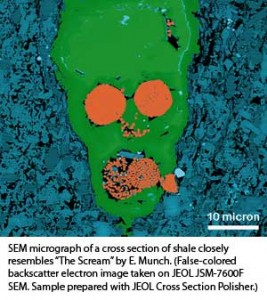A March 7, 2017 news item on phys.org describes some of the US Argonne National Laboratory’s research into oil spill cleanup technology,
When the Deepwater Horizon drilling pipe blew out seven years ago, beginning the worst oil spill [BP oil spill in the Gulf of Mexico] in U.S. history, those in charge of the recovery discovered a new wrinkle: the millions of gallons of oil bubbling from the sea floor weren’t all collecting on the surface where it could be skimmed or burned. Some of it was forming a plume and drifting through the ocean under the surface.
Now, scientists at the U.S. Department of Energy’s (DOE) Argonne National Laboratory have invented a new foam, called Oleo Sponge, that addresses this problem. The material not only easily adsorbs oil from water, but is also reusable and can pull dispersed oil from the entire water column—not just the surface.
A March 6, 2017 Argonne National Laboratory news release (also on EurekAlert) by Louise Lerner, which originated the news item, provides more information about the work,
“The Oleo Sponge offers a set of possibilities that, as far as we know, are unprecedented,” said co-inventor Seth Darling, a scientist with Argonne’s Center for Nanoscale Materials and a fellow of the University of Chicago’s Institute for Molecular Engineering.
We already have a library of molecules that can grab oil, but the problem is how to get them into a useful structure and bind them there permanently.
The scientists started out with common polyurethane foam, used in everything from furniture cushions to home insulation. This foam has lots of nooks and crannies, like an English muffin, which could provide ample surface area to grab oil; but they needed to give the foam a new surface chemistry in order to firmly attach the oil-loving molecules.
Previously, Darling and fellow Argonne chemist Jeff Elam had developed a technique called sequential infiltration synthesis, or SIS, which can be used to infuse hard metal oxide atoms within complicated nanostructures.
After some trial and error, they found a way to adapt the technique to grow an extremely thin layer of metal oxide “primer” near the foam’s interior surfaces. This serves as the perfect glue for attaching the oil-loving molecules, which are deposited in a second step; they hold onto the metal oxide layer with one end and reach out to grab oil molecules with the other.
The result is Oleo Sponge, a block of foam that easily adsorbs oil from the water. The material, which looks a bit like an outdoor seat cushion, can be wrung out to be reused—and the oil itself recovered.
At tests at a giant seawater tank in New Jersey called Ohmsett, the National Oil Spill Response Research & Renewable Energy Test Facility, the Oleo Sponge successfully collected diesel and crude oil from both below and on the water surface.
“The material is extremely sturdy. We’ve run dozens to hundreds of tests, wringing it out each time, and we have yet to see it break down at all,” Darling said.
Oleo Sponge could potentially also be used routinely to clean harbors and ports, where diesel and oil tend to accumulate from ship traffic, said John Harvey, a business development executive with Argonne’s Technology Development and Commercialization division.
Elam, Darling and the rest of the team are continuing to develop the technology.
“The technique offers enormous flexibility, and can be adapted to other types of cleanup besides oil in seawater. You could attach a different molecule to grab any specific substance you need,” Elam said.
The team is actively looking to commercialize [emphasis mine] the material, Harvey said; those interested in licensing the technology or collaborating with the laboratory on further development may contact partners@anl.gov.
Here’s a link to and a citation for the paper,
Advanced oil sorbents using sequential infiltration synthesis by Edward Barry, Anil U. Mane, Joseph A. Libera, Jeffrey W. Elam, and Seth B. Darling. J. Mater. Chem. A, 2017,5, 2929-2935 DOI: 10.1039/C6TA09014A First published online 11 Jan 2017
This paper is behind a paywall.
The two most recent posts here featuring oil spill technology are my Nov. 3, 2016 piece titled: Oil spill cleanup nanotechnology-enabled solution from A*STAR and my Sept. 15, 2016 piece titled: Canada’s Ingenuity Lab receives a $1.7M grant to develop oil recovery system for oil spills. I hope that one of these days someone manages to commercialize at least one of the new oil spill technologies. It seems that there hasn’t been much progress since the BP (Deepwater Horizon) oil spill. If someone has better information than I do about the current state of oil spill cleanup technologies, please do leave a comment.


